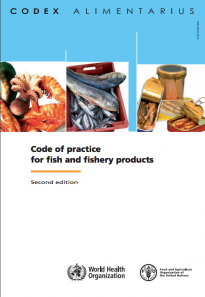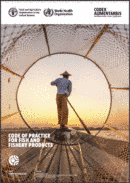Refrigerated Road Transport
Refrigerated road transport is an essential link in cold chains that aims to supply the consumer with safe, high-quality fish and fish products. Refrigeration enables fish and fish products to be transported long distances in a temperature-controlled environment which helps to maintain quality and prevent or slow down spoilage and hence prevent food loss and waste (FLW). Refrigerated road vehicles can be grouped into three main types:
- small converted vans (up to 3.5 tonnes)
- rigid vehicles (trucks, up to 32 tonnes) and
- articulated vehicles (up to 44 tonnes
Key causes of FLW include:
Fish at the edges and corners of a load will warm more quickly than those at the centre of the load during unrefrigerated transport. The temperature rise is typically in the outer 300mm layer of the load and this layer can represent a considerable part of the total load. For example, in a container measuring 5 x 2 x 2m almost 60 percent of the load would be located within 300mm of the wall. Such warming will be greater in warmer climates
Temperature maintenance throughout the chain is essential for success, and the finest transport equipment cannot compensate for poor handling at loading, wrong packaging and stowage, or inadequate product cooling.
Wrong temperature-setting on transport equipment may lead to foodstuffs being heated, whereas in many static stores it would only lead to lack of refrigeration
Use of refrigerated transport equipment to cool fish and fish products as opposed to maintaining the temperature of already cooled products
Poor air circulation
Lack of temperature control
Lack of attention to stowage of product within the vehicle.
Refrigeration Methods and Temperature
Refrigeration Methods and Temperature
The following refrigeration methods are used:
- Mechanical refrigeration using either wall coolers or forced convection coolers blowing air throughout the storage space. In some cases, a jacketed system for distributing the air is employed. This is the most common system.
- Rechargeable eutectic plates.
- Solid or liquid carbon dioxide or liquid nitrogen
The temperature of chilled products must be as close as possible to 0 °C or, for frozen fish, shellfish and their products, to maintain a temperature of –18 °C or colder (except for brine frozen fish intended for canning which may be transported at –9 °C or colder).
The initial temperature of the fish, whether the vehicle is fully or partly loaded, the size of the load, the insulation quality and thickness, the degree of air ingress and the local climatic conditions all influence the efficiency and temperature control. A local trial will ascertain the maximum range attainable. But generally speaking, the temperature control requirements for chilled foods are more difficult to achieve than those for frozen foods. Typically, it may be necessary to maintain cook-chill products between 0C and 5ºC, and for many products closer tolerances are required, whereas with frozen foods there will be an upper limit temperature, perhaps –18ºC, but no lower limit.
Refrigerated Containers
Refrigerated Containers
Refrigerated containers or reefers – also known as intermodal freight containers (‘ISO’ containers) with integral refrigeration machinery – are widely used for the long-distance transport of fresh/chilled and frozen seafood. This equipment is capable of maintaining either frozen or chilled goods at any selected temperature between –25°C and +30°C in ambient temperatures from –20°C to +50°C. Air flows from the bottom container to the top. Warmer air is pulled from inside the container, chilled inside the refrigeration unit and forced back inside. Integrated containers typically have grated floors to ensure proper ventilation and air circulation. These containers are either 20 of 40 feet in length (1 foot = 0.3048 meters), and can be transported by road as well as sea.
There are logistics companies which specialize in refrigerated fish transport. Some have custom built equipment to cope with the needs of the fishing industry.
Key Publications
Cold Chain in Seafood Industry This guide addresses developments in seafood cold chain including selected aspects of refrigeration process (including equipment and storage conditions of chilling and freezing), safety and shelf–life issues, and regulation and legislation. | |
International Institute of Refrigeration (IIR) The IIR is the only independent intergovernmental science and technology based organization that promotes knowledge of refrigeration fields. Key issues addressed include food safety, health, energy saving and efficiency, global warming and ozone depletion. | |
Code of Practice for Fish and Fishery and Fishery Products Codes of practice and guidelines designed to help meet standards and comply with legislation (e.g the Codex Alimentarius Code of Practice for Fish and Fishery Products). |
More Resources
More Resources
31 October 2023














